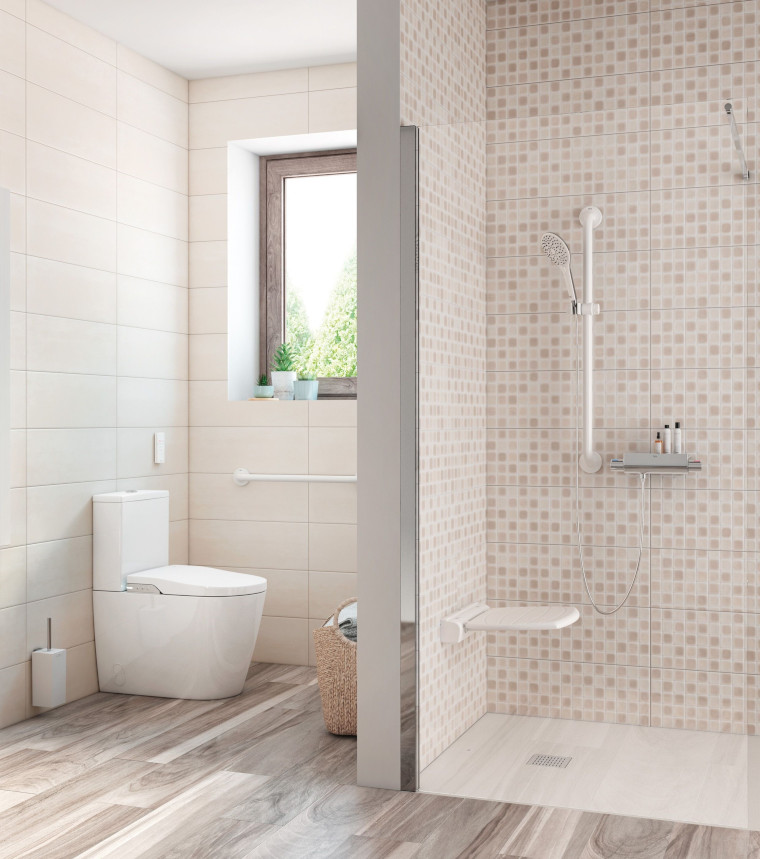Can thoughtful interior design help an ageing population stay in their homes for longer? I asked BIID members Gilly Craft and Lori Pinkerton-Rolet for their insights.
Gilly Craft is a past president of the BIID and managing director and Lead Designer at Koubou Interiors Lori Pinkerton-Rolet is director of Park Grove Design Ltd. Both have experience designing residential interiors for the elderly.
What are the key considerations when designing interiors for the elderly?
GC: It is crucial, when designing for any client with a special need or keen to future proof their property, that you fully understand the brief. A lot more information needs to be gathered than normal.
Does the client have mobility, sight or hearing problems? Does dementia need to be considered? Ask the client whether they can identify the key issues with the property as it stands. Space planning must be the first consideration because of wider doorways, lifts, hoists or ramps may need to be installed, then this will drive the whole project. Future proofing is important, so making sure everything is thought through is crucial. If the client has an occupational therapist or carers, then working with them is helpful.
LP-R: Everyone ages, and while challenges which can come with age vary from person to person there are certainly some general issues which can be addressed through design:
Manual dexterity- arthritis can make something as simple as a doorknob challenging as people age. Lever handles on doors and wide drawer pulls, rather than single knobs, can be helpful.
Mobility – many people in wheelchairs didn’t think they’d ever be using one – until their physical situation evolved. It make sense to minimise changes of level where possible, or ramp between spaces. It is ‘inclusive design’ which looks smart and contemporary without directly pointing to age-proofing. Mobility does not simply mean wheelchairs. There are beautiful sleek rails which look exactly like smart towel rails but are grab bars which take full body weight when and if you need them to be.
Eyesight – macular degeneration is a common condition as people age. Glare can make it extremely difficult to focus and see clearing if this is an issue. Therefore having diffusers on lights, dimmers, or assuring lights are not placed where people can look directly into the bulb makes sense.
The lenses in our eyes yellow with age, not unlike a newspaper (only you can’t see it). As a result, less light hits the back of our eye as we get older. Higher light levels are helpful so it’s a good idea to make sure you have plenty of light available when doing new designs or refurbishments and using dimmers to control what is pleasant and useful along the way.

Which rooms need particular consideration when designing interiors for the elderly?
GC: Kitchens and bathrooms. Being able to turn on taps or use the bath or shower is important and there are a lot of companies doing accessible bathing components now. A toilet pan needs to be higher and grab rails may be needed.
In the kitchen, the worktop height and positioning of electrical sockets may need to be different to the norm. Having the correct flooring is vital to avoid trips and falls. Lighting is another important element as sight diminishes with age, so how components and colour are used has to be well thought out. Using LRV (light reflectance value) in designing the space will help with wayfinding.
LP-R: Bathrooms and kitchens need particular consideration as these are also the areas in which most home accidents occur. Designers who specialise in design for older people use LRV ratings to ensure at least a minimum depth of colour contrast between elements such as countertops and floors. The more clarity an ageing homeowner has as to where surfaces start and finish, the better.
Does smart home technology have a role to play?
GC: Yes probably, but remember you may be dealing with someone that could have vision issues. Dementia also makes the environment around you difficult to understand, so keep things very simple. Voice activated technology would be the best choice.
LP-R: Technology can be an enormous help in turning off and on appliances, lighting and even security systems. The costs have dropped considerably and if you have Wi-Fi then an interactive speaker system (Google Dot, etc.) and a smart plug will take you very far indeed!
Can considerate interior design help us stay in our homes for longer?
GC: Without a doubt. The needs of the client now and going forward have to be the driving force before any other consideration in the design process. Everyone deserves good design. A space designed for someone with a particular need does not need to look clinical.
LP-R: Have you ever met anyone who doesn’t age? Me neither, but we don’t tend to design as a society with this in mind. Without question considerate interior design can keep us in our homes for longer or for the rest of our lives.
When people need assistance following, say, an accident, local councils have been known to send someone to assess the suitability of a person’s interior. They will then install ugly hospital-type rails and other interventions. It’s much more desirable to not have an accident to begin with because thoughtful design has already been built into the home.
Are there any particular products or brands you can recommend for an age aware interior?
GC: Johnstones Paints put the LRV values on their paint charts. Many bathroom companies now do accessible bathroom components – Ideal Standard have a good choice.
Also, consider commercial flooring suppliers, they are now doing lovely flooring that is fit for purpose try Gerflor or Polyflor. I like Panaz and Sekers for fabrics and Stiltz for home lifts.
LP-R: There are brands which might have one or two products each which you’d put into anyone’s home which supports all age ranges. That’s the standard we want to work to as a society. I know of no one-stop shopping though. If you join Third Age Design (it’s free) you can ask specific questions in the Forum and experts in this area of design will reply.



